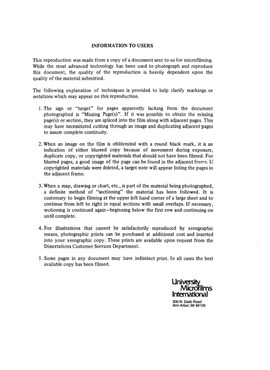| dc.contributor.author | Shabahang, Homa, | en_US |
| dc.date.accessioned | 2013-08-16T12:28:55Z | |
| dc.date.available | 2013-08-16T12:28:55Z | |
| dc.date.issued | 1983 | en_US |
| dc.identifier.uri | https://hdl.handle.net/11244/5140 | |
| dc.description.abstract | Initially, the long-run patterns of association among the economic and non-economic variables were tested through the analysis of factorial structure for the entire thirty-six year period. Then, the short-run factorial structures were tested for three sub-periods each representing thirteen, nine, and fourteen years of Iranian social development respectively. | en_US |
| dc.description.abstract | The analysis of the short-run and the long-run factorial structures of Iranian economy reveal that sociological and political environments are highly interwoven with the economic sphere in the process of development. All these three dimensions of development have to progress hand-in-hand. Otherwise, one domain will pose as a bottleneck to economic development. So, our first hypothesis is accepted. | en_US |
| dc.description.abstract | The second hypothesis could not be accepted based on the fact that the association among economic and non-economic variables decrease from our first sub-period to the second but increased from second to the third sub-period. Sociological variables seem to have been positively associated with economic progress all through the analysis. The political variables, on the other hand, suggest the hypothesis that in the third sub-period, uneven progress in this domain has acted as a bottleneck for sociological and economic progress. It is concluded that the patterns of association among the three domains of development are not stable through time. | en_US |
| dc.description.abstract | The country chosen as our case study was Iran. The method of factor analysis was employed for data reduction and analysis. Twenty-five indicators representing economic, political, and sociological spheres of the Iranian economy were generated for the thirty-six year period from 1941 to 1976. | en_US |
| dc.description.abstract | This study was concerned with the strong interrelationship between the sociological and political environment on one hand and the economic environment on the other in the development process of the less developed countries. The two following hypotheses were tested in this study: (1) There is a strong association among economic and non-economic variables in the development process. (2) As a country advances to higher levels of economic development, the degree of association among non-economic variables on one hand and the economic variables on the other is reduced. | en_US |
| dc.description.abstract | In the economic domain, the analysis suggests that the vast transformation of the economy from an agricultural mode of production to other sectors as the main source of GNP has had increasing association with political tension variables. | en_US |
| dc.format.extent | x, 151 leaves : | en_US |
| dc.subject | Economics, General. | en_US |
| dc.title | An analysis of the development process of LDC with particular reference to Iran. | en_US |
| dc.type | Thesis | en_US |
| dc.thesis.degree | Ph.D. | en_US |
| dc.thesis.degreeDiscipline | Michael F. Price College of Business | en_US |
| dc.note | Source: Dissertation Abstracts International, Volume: 44-02, Section: A, page: 0538. | en_US |
| ou.identifier | (UMI)AAI8314790 | en_US |
| ou.group | Michael F. Price College of Business | |
